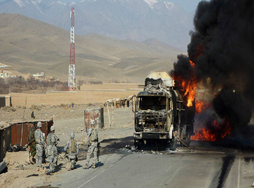War zones are dangerous places. Where better, then, for a nuclear reactor?
战区是危险的地方。对核反应堆来说,却是个好地方。
On March 9th America's government awarded a trio of firms $39.7m
3月9日,美国政府给三家公司拨款3970万美元,
to design "microreactors" that can supply a few megawatts of power to remote military bases,
用于设计“微型反应堆”,为偏远的军事基地提供几兆瓦的电力,
and be moved quickly by road, rail, sea and air.
并可通过公路、铁路、海路和空路快速移动。
The idea of small reactors is as old as nuclear power itself. In July 1951,
小型反应堆的想法和核能一样古老。1951年7月,
five months before a reactor in Idaho became the first in the world to produce usable electricity through fission,
爱达荷州的一个反应堆成为世界上第一个通过裂变产生可用电力的反应堆的5个月前,
America began building USS Nautilus, a nuclear-powered submarine.
美国开始建立鹦鹉螺号核动力潜艇。
In the 1960s and 1970s small reactors powered bases in Alaska and Greenland,
上世纪60和70年代,小型反应堆为阿拉斯加和格陵兰岛的基地、
a radar facility in Wyoming, a research station in Antarctica and—from a cargo ship— the Panama Canal Zone.
怀俄明州的一个雷达设施、南极洲的一所研究站以及巴拿马运河区提供动力。
America still uses nuclear-powered submarines and aircraft-carriers.
美国仍在使用核动力潜艇和航空母舰。

原子能--小型裂变.jpg
But land-based mini-reactors proved unreliable and expensive and have fallen out of favour.
但事实证明陆基迷你反应堆并不可靠、造价昂贵,已经失宠。
Interest has been revived by recent wars, in which American forces proved extraordinarily hungry for energy.
最近的战争重新激起了人们的兴趣,在这些战争中,美国军队被证明极度渴求能源。
Early in the Iraq war, fuel made up over a third of the tonnage transported to the region.
早在伊拉克战争中,运往该地区的燃料占总吨位的三分之一以上。
Between 2001 and 2010, over half of American casualties in Iraq and Afghanistan occurred during land-transport missions,
在2001年和2010年间,在伊拉克和阿富汗超过一半的美军伤亡是在地面运输任务中发生的,
many involving fuel deliveries to remote outposts.
其中很多都是向边远哨所运送燃料。
Portable reactors could substitute for unreliable power grids or the generators that often take their place.
便携式反应堆可以替代不可靠的电网或取代它们的发电机。
America's armed forces use about 30 terawatt-hours of electricity per year— about the same as Ireland—
美国武装部队每年大约消耗30太瓦时的电力——与爱尔兰差不多——
and more than 35m litres of fuel per day. In 2016 a report by the Defence Science Board, a committee of experts,
以及每天超过3500万升的燃料。2016年,美国国防部科学委员会的一份报告
concluded that demand would surge as new power-hungry weapons, like lasers and rail-guns, come to maturity.
总结到随着新型高功率武器,如激光和轨道炮的成熟,需求将会激增。
Vehicles are also moving away from fossil fuels: America expects to have all-electric brigades within the decade.
车辆也正在远离化石燃料:美国预计在十年内将拥有全电动车队。
A report by the army in 2018 said that Holos, a prototype mobile nuclear reactor, would be 62% cheaper than using liquid fuel.
2018年的军方报告称原型移动核反应堆Holos将比使用液体燃料便宜62%。
It is not just American troops experimenting with mobile nuclear power.
不仅仅是美国军队在试验移动核能。
NASA is developing smaller "Kilopower" reactors for space missions, designed to power small lunar outposts.
美国宇航局正在为太空任务开发更小的“Kilopower”反应堆,为小型月球前哨提供动力。
Russia already uses larger floating reactors for its nuclear-powered icebreakers.
罗斯已经在使用更大的浮动反应堆来建造核动力破冰船。
China plans to install similar devices on disputed islands in the South China Sea.
中国计划在中国南海岛屿安置类似装置。
But the planned microreactors would be distinct in several ways.
但是拟定的微反应堆在几个方面有所不同。
They are intended to be assembled in a factory and shipped in one piece,
他们打算在工厂进行组装,并整体运输,
doing away with the need for tricky engineering in remote places.
这样就不需要在偏远地区进行复杂的工程。
They should weigh under 40 tonnes and fit onto the back of an articulated lorry.
它们的重量应在40吨以下,安装在一辆铰接式卡车的后面。
And they are supposed to run themselves, with "minimal monitoring" from afar.
有了远处的“最少限度的监控”,它们应该能够自动运行。
The risks are manageable, say proponents. Designs feature "passive safety" systems,
倡议者表示风险是可控的。设计的特点是“被动安全”系统,
which keep working even if electricity is lost or a component breaks.
即使停电或部件损坏,该系统仍能继续工作。
Cooling pumps can be replaced by natural convection currents, for instance.
例如,冷却泵可以用自然对流代替。
The reactors use "tristructural isotropic particle fuel", in which blobs of fissile uranium
反应堆使用了“三结构各向同性颗粒燃料”,其可裂变铀
(along with oxygen and carbon) are wrapped in layers of carbon and silicon carbide.
(以及氧和碳)的斑点被包裹在碳和碳化硅层中。
The pellets can withstand high temperatures, contain radioactive contamination and limit the impact of accidents.
这些微粒可以耐得住高温、含有放射性污染,并限制事故的影响。
The reactors themselves "would be shielded and protected,
反应堆本身“将被隔离和保护,
and possibly placed in a hole in the ground", says Bill Lee, a nuclear engineer and materials scientist at Bangor University, in Wales.
并可能被放置在战场的一个洞穴中”,威尔士班戈大学的一位核工程师和材料科学家比尔·李说到。
A nuclear meltdown should be "physically impossible", says the Pentagon. The grunts on the ground will be hoping that is right.
国防部表示,核反应堆熔毁“在物理学上是不可能的”。战场上的士兵会希望是这样的。
来源:经济学人

参与评论